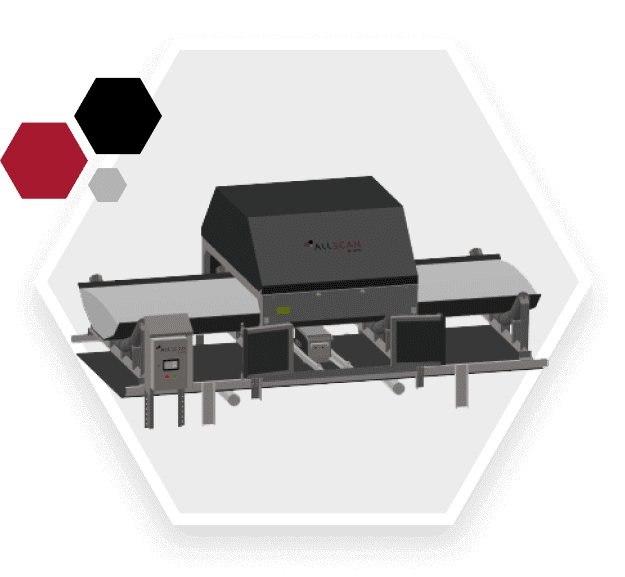AllScan n-Gen
Steel Production
The AllScan n-Gen analyser uses world-first neutron generation technology with ground-breaking spectra modelling and powerful statistical analysis in provision of elemental analysis in real time. Installed on a conveyor belt, the AllScan delivers accurate, minute-by-minute elemental analysis and reporting of the chemical composition of bulk materials and key process parameters.
AllScan n-Gen
AllScan N-Gen is a quantum leap in analyser technology, delivering higher yields, increased returns, and lower costs for your operation.
- World-best n-Gen analyser innovation
- Simple, intuitive calibration
- Lowest cost of operation in the market
- Maximise output, minimise downtime and costs
- Shore up site and resource sustainability
Theory of Operation
At the heart of the AllScan is Neutron Generation (n-Gen) technology. Material on the conveyor is bombarded with neutrons emitted from a radioactive isotope or neutron accelerator.
RTI has incorporated a revolutionary new neutron generator design into the AllScan n-Gen elemental analyser.
AllScan n-Gen incorporates a sophisticated algorithm - DuraG™ - that separates the effect of belt loading and profile variation on the measured spectra from the effect of elemental variation on the elemental spectra. DuraG™ dramatically reduces measurement error.
AllScan n-Gen also includes - DuraSum - a powerful algorithm that eliminates the need for time-based averaging of data in order to obtain stable results. This means that significant changes in elemental composition are reported almost instantaneously, rather than minutes later. This in turn allows for rapid operational control.
These breakthrough technologies combine with the reliability of the n-Gen measurement technique to deliver the most accurate and responsive coal elemental analyser on the market today.
New cutting edge design eliminates the need for air conditioners to cool the electronics. The AllScan package is provided in a small footprint fully contained, and is the smallest n-Gen on the market.
The AllScan n-Gen comes with an intrinsically safe auto source on/off source drive mechanism.
The generator life span is more than 10 years.
There is a constant output of neutrons, with no decay over time as with Cf-252 sources.
The only maintenance requirement is that re-gassing is required every 2.5 - 3 years. When neutrons collide with an element in the material, gamma rays are emitted with a specific energy unique to that element – in effect, creating a chemical signature for that element. The greater the amount of an element in the material the greater the number of gamma rays emitted with the corresponding specific energy. By measuring the specific energy of the gamma rays that are emitted, and the counts of gamma rays, an accurate analysis of the chemistry of the material is generated on a second-by-second basis.
AllScan n-Gen measurement parameters and benefits
The AllScan can be applied to measure the quality of the incoming raw materials to enable operators to produce pre-blended stockpiles based on preferred parameters such as Fe, Mg, Si, Ca etc content. The pro-active control of pre-blending result in a more consistent quality product delivery into downstream processes like sinter and coke production, blast furnace feed and ultimately the final product delivery. Parameters such as:
Basicity (Ca/Si) can be controlled to produce higher throughput rates in the sintering process, increase burn through and reduce the amount of fines requiring additional processing and associated costs. The basicity of sinter material is an important parameter to ensure the efficient operation of the sintering and ultimately iron production process. The AllSan for sinter measure the sinter feed chemistry in real time and provide minute by minute data to enable pro-active control of the basicity. With additional control software the process of basicity correction can be done automatically resulting in a more consistent sinter product with reduced fines and increased sinter oven throughput.
The measurement of important elements like:
- Silver (Ag)
- Aluminium (Ag)
- Gold (Au)
- Calcium (Ca)
- Cadmium (Cd)
- Chlorine (Cl)
- Cobolt (Co)
- Chromium (Cr)
- Copper (Cu)
- Iron (Fe)
- Magnesium (Mn)
- Sodium (Na)
- Nickel (Ni)
- Phosperous (P)
- Sulphur (S)
- Silicon (Si)
- Titanium (Ti)
- Vanadium (V)
- Zinc (Z)
provide operators with real time data on elemental concentration levels to increase efficiency, reduce operating costs and ultimately improve bottom line profitability.



